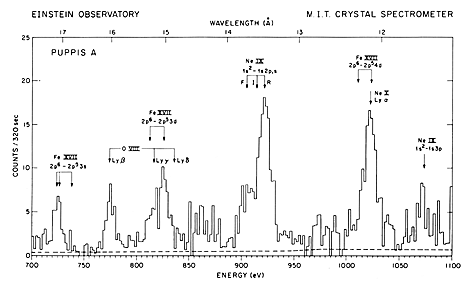X-ray spectra of a knot in the Puppis A remnantX-ray spectrum of a bright knot in Puppis A from the Einstein Focal Plane Crystal Spectrometer (FPCS). This prominant feature on the east limb of Pup A was selected as one of the prime targets for the Einstein FPCS because of its X-ray brightness. The spectral resolution of this instrument is a hundred times greater than anything used before, and this is the first non-solar, high-resolution, X-ray spectrum to show sharp features. i Emission lines from highly ionized oxygen, neon, and iron were clearly detected. Using date from these lines, elemental abundances and temperatures of the gas were calculated. The results showed that oxygen and neon were present with a concentration (relative to iron) 3-5 times greater than normal, indicating that this supernova explosion was the result of gravitational collapse of a massive star. These elements are expected to be found in the outer layers of such a star. Courtesy of F. Winkler and colleagues (MIT). Reproduced from Figure 3-14 in Charles and Seward.
IMAGES |
By Mission |
Stars |
HEASARC Home | Observatories | Archive | Calibration | Software | Tools | Students/Teachers/Public Last modified: Thursday, 26-Jun-2003 13:48:44 EDT |


